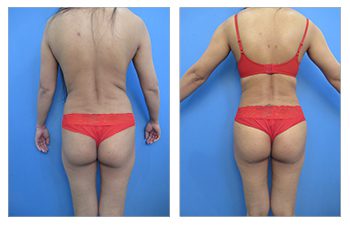Introduction: Liposuction of Knees
Liposuction of knees has evolved over the last few years with the advent of combined Helium plasma and radiofrequency energies, coined Renuvion J plasma. Traditionally, liposuction of the knees was reserved for only the medial knee fat pad. Universally, all female clients demonstrate some degree of excess fat over the medial knees.
Even athletic clients tend to accumulate some fat in the knees. Removal of this localized fat pad is common and can make your legs seem sleek and more attractive. Additionally, the skin of the medial knees universally possesses good texture and is amenable to recoiling back down when the fat is removed. Unfortunately, another aspect of the knee that is often a concern has not been treatable traditionally.
This stubborn area is located over the anterior knee just above your kneecap. This area of the knee is difficult to treat because, in contrast to the medial knee, it typically possesses redundant skin. As such, routine liposuction of knees over the anterior knee has been frowned upon. Due to the location of this concern area, excision of skin has not been favorable.
Today, with the advent of the combined Helium plasma radiofrequency energy, the redundant skin over the anterior knee can be tightened. As a result, liposuction of knees over the anterior surface is now possible. In summary, liposuction of the anterior knees can now be performed but only conservatively, as the capacity of the Renuvion J plasma to tighten the resulting redundant skin is limited.
Overall, Renuvion J plasma can accommodate only minimal to moderate skin redundancy. Regardless, we can now offer patients who are concerned about anterior knee fullness a treatment that was not available previously. If you are not happy about the appearance of your knees, we encourage you to set up a virtual consultation with one of our liposuction specialists.

The Art and Science of Liposuction of Knees: A Detailed Exploration
Introduction to Liposuction of Knees
Liposuction of knees is a specialized cosmetic surgery procedure designed to sculpt and contour the knee area. It addresses concerns related to excess fat around the knees, which can be resistant to diet and exercise. This procedure is increasingly sought after for its ability to enhance the appearance of the lower legs and create a more balanced, aesthetically pleasing leg contour.
Understanding the Procedure
Knee liposuction involves the removal of fat from around the knee area. Surgeons make tiny incisions in strategic locations to access and remove the fat. The procedure is typically performed using a cannula, a thin tube that breaks up and suctions out the fat. This technique improves the contour of the knees, harmonizing them with the thighs and calves.
Innovations of Liposuction of Knees
Recent advancements in liposuction technology have enhanced the safety and efficacy of knee liposuction. Techniques like Shrink-Wrap Liposuction and SAFELipo offer minimally invasive options with remarkable results. These methods focus on skin tightening, fat melting, and ensuring smooth contours without irregularities.
The Benefits of Liposuction of Knees
Patients who undergo knee liposuction often experience a significant boost in self-confidence due to the improved appearance of their legs. The procedure can effectively address issues like disproportionate fat distribution around the knees, enhancing the overall silhouette of the lower body.
Recovery and Aftercare
Recovery from knee liposuction is generally swift, with patients able to resume normal activities within a few days. It’s important to follow the surgeon’s post-operative care instructions closely to ensure optimal healing and results.
Choosing the Right Surgeon
Selecting an experienced and skilled plastic surgeon is crucial for a successful knee liposuction procedure. Prospective patients should research and consult with reputable surgeons who specialize in this area to ensure the best possible outcomes.
Common liposuction techniques used on the knees include:
- Tumescent liposuction using local anesthetic fluid
- Ultrasound-assisted liposuction to liquefy fat
- Laser-assisted liposuction to tighten skin
The procedure time depends on the extent of treatment needed. But most knee liposuctions take under 2 hours in total.
What is Recovery Like After Knee Liposuction?
Patients will wear compression garments on the knees for 2-4 weeks post-procedure. Minor bruising, swelling, and discomfort are common temporary side effects. Most individuals can resume normal activity in 7-10 days.
Results become visible in 2-3 months as swelling subsides completely. The final contour is apparent around six months post-op. A balanced diet and exercise help maintain your new knee shape long-term.
What Are the Benefits of Liposuction on the Knees?
Some benefits of knee liposuction include:
- Permanently removes fat cells in the knees
- Reshape knees for a slimmer, smoother appearance
- Provides better knee definition and muscle tone
- Works on knees resistant to diet and exercise
- Minimal scarring due to small access incisions
- Smooths bumpy fat deposits around the knees
What Are the Potential Risks to Consider?
Despite being a generally safe procedure, knee liposuction has some risks:
- Temporary bruising, swelling, numbness, and pain
- Permanent skin discoloration in rare cases
- Indentations from fat removal unevenness
- Loose skin if older with poor elasticity
- Vein thrombosis risk from knee compression
- Infection in the incision sites
Who is the Ideal Candidate for Knee Liposuction?
The best candidates for knee liposuction are those who:
- Are within 30 lbs of their ideal weight
- Do not have major health issues
- Have good skin elasticity
- Have focal fat deposits around the knees
- Are nonsmokers
- Have realistic expectations for results
Conclusion: Liposuction of knees
Knee liposuction offers a transformative solution for individuals looking to refine the appearance of their knees and lower legs. With the latest advancements in liposuction techniques, patients can achieve their desired results with minimal downtime and maximum safety. Knee fat removal can be performed successfully in 2024.

